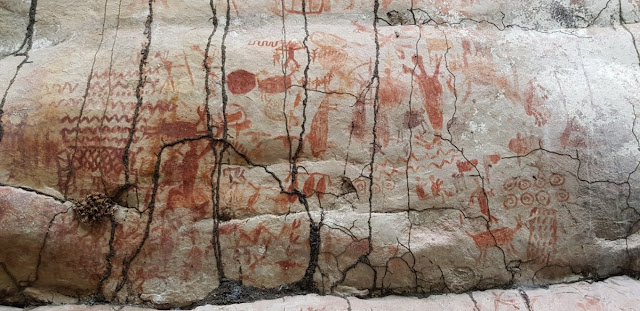Tens of thousands of paintings of animals and humans, made up to 12,600 years ago, were found along the Guayabero River in the Colombian Amazon.
by Hakim Bishara
A trove of ancient
cave art was discovered in the Columbian Amazon (courtesy of Ella Al-Shamahi)
In a remarkable discovery, archaeologists have found one of the
world’s largest collections of prehistoric rock art in the Amazonian
rainforest.
Tens of thousands of paintings of animals and humans, made up to
12,600 years ago, were found on an eight-mile rock surface along the Guayabero
River in the Colombian Amazon.
Called “the Sistine Chapel of the ancients,” the collection
includes drawings of large mammals, birds, fish, lizards, handprints, and
masked figures of dancing humans. The ancient paintings also record
interactions between humans and extinct species of giant Ice Age mammals like
mastodons.
The discovery belongs to a joint team of Colombian-British
researchers, led by Jose Iriarte, a professor of archaeology at Exeter
University in the United Kingdom. The archeologists conducted the main bulk of
excavations in the area between 2017-2018 with the intent of revealing their
findings in the documentary series Jungle Mystery: Lost Kingdoms of the Amazon,
which will air on the British Channel 4 starting December 5. The documentary’s
presenter is Ella Al-Shamahi, an archaeologist and explorer. The findings are also outlined in an article in the journal Quaternary
International.
In an email to Hyperallergic, the researchers
wrote: “The excavations, in the deep soil around the shelters, have revealed
one of the earliest secure dates for the occupation of the Colombian Amazon and
clues about people’s diet at this time, as well as the remains of small tools
and scraped ochre used to extract pigments to make the paintings.”
The team has also found realistic drawings of
deer, tapirs, alligators, bats, monkeys, turtles, serpents, and porcupines.
There are also depictions of creatures resembling a giant sloth, camelids,
horses, and three-toe ungulates with trunks.
“These native animals all became extinct,
probably because of a combination of climate change, the loss of their habitat
and hunting by humans,” the researchers wrote.
According to the researchers, communities that
lived in the area at the time of the drawings were hunter-gatherers who fished
in the nearby river. Remains of bones and plants found during the excavations
shed information about their diets, which included palm and tree fruits,
piranha, alligators, snakes, frogs, rodents such as paca, capybara, and
armadillos.
“The paintings, on specially prepared rock walls of the Serranía La Lindosa, on the northern edge of the Colombian Amazon, is further evidence of the impact early human communities had on the Amazon’s biodiversity and their adaption to climate change,” the archaeologists wrote. “At the time the drawings were made temperatures were rising, starting the transformation of the area from a mosaic landscape of patchy savannahs, thorny scrub, gallery forests and tropical forest with montane elements into the broadleaf tropical Amazon forest of today.”
From the Channel 4series Jungle Mystery: Lost Kingdoms of the Amazon: Presenter Ella Al-Shamahi’s hand in front of the ancient handprints (Photo by Marie-Claire Thomas/Wild Blue Media)
A bitter civil war that continued in Colombia
for five decades had prevented access to the region, which was under the
control of the anti-government Revolutionary Armed Forces of Colombia (FARC)
guerrillas. It wasn’t until 2016, when the FARC and the Colombian government
signed a peace agreement, that researchers could access the cave paintings.
Iriarte’s team of archaolegists includes Gaspar Morcote-Ríos and
Jeison L. Chaparro-Cárdenas from the Universidad Nacional de Colombia;
Francisco Javier Aceituno from the Universidad de Antioquia; and Mark Robinson
from the University of Exeter.
“These rock paintings are
spectacular evidence of how humans reconstructed the land, and how they hunted,
farmed and fished,” said Iriarte. “It is likely [that] art was a powerful part
of culture and a way for people to connect socially. The pictures show how
people would have lived amongst giant, now extinct, animals, which they
hunted.”
Robinson added that the cave art was produced
by the earliest people to live in western Amazonia.
“The paintings give a vivid and exciting
glimpse into the lives of these communities,” the researcher said. “It is
unbelievable to us today to think they lived among, and hunted, giant
herbivores, some which were the size of a small car.”
https://hyperallergic.com/605541/archaeologists-discover-eight-miles-of-prehistoric-rock-art-the-sistine-chapel-of-the-ancients/?utm_campaign=Daily&utm_content=20201209&utm_medium=email&utm_source=Hyperallergic%20Newsletter


No hay comentarios:
Publicar un comentario